🐈🌌🚀
🐈🌌🚀



Alien Directed by Ridley Scott (1979)
More Posts from Monstrous-mind and Others
🍂🍁🌄

🎃🍂🍁🍂🎃🍂🍁🍂🎃🍃🐈🐾

🔭🌃🌌🍂🍁🐈
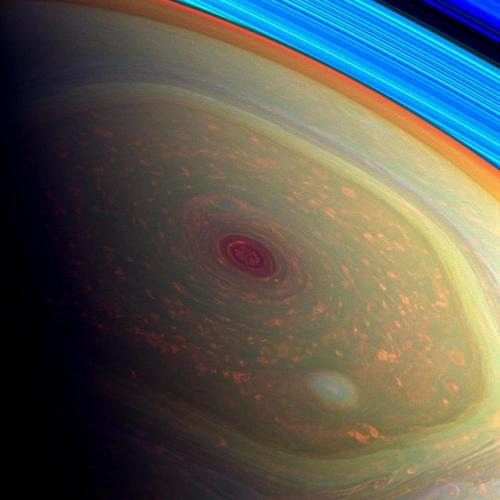
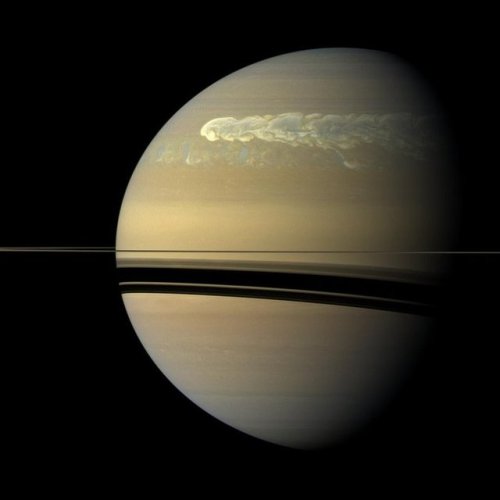
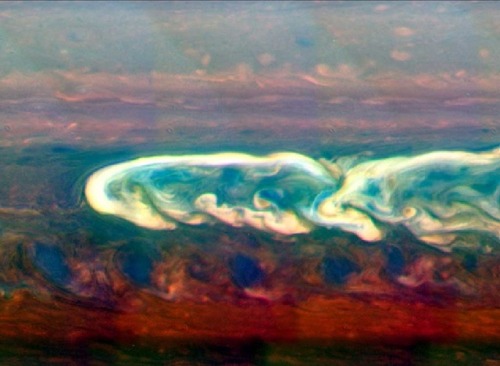



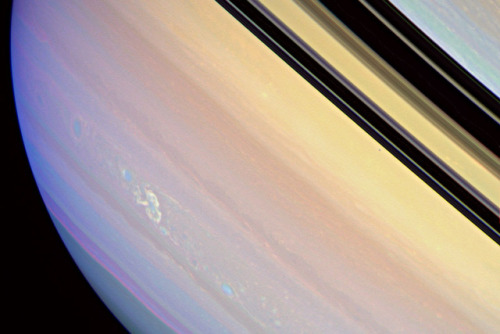

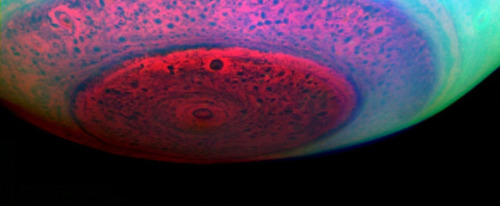
Saturn’s atmosphere exhibits a banded pattern similar to Jupiter’s, but Saturn’s bands are much fainter and are much wider near the equator. The nomenclature used to describe these bands is the same as on Jupiter. Saturn’s finer cloud patterns were not observed until the flybys of the Voyager spacecraft during the 1980s. Since then, Earth-based telescopy has improved to the point where regular observations can be made. The composition of the clouds varies with depth and increasing pressure.
The winds on Saturn are the second fastest among the Solar System’s planets, after Neptune’s. Voyager data indicate peak easterly winds of 500 m/s (1,800 km/h).
Thermography has shown that Saturn’s south pole has a warm polar vortex, the only known example of such a phenomenon in the Solar System. Whereas temperatures on Saturn are normally −185 °C, temperatures on the vortex often reach as high as −122 °C, suspected to be the warmest spot on Saturn.
Credit: NASA/JPL-Caltech/Space Science Institute and Kevin M. Gill
🔭🌃🌌
Characteristics of the moons of Saturn
Saturn has 62 natural satellites. Here are some features of some of its moons, with mountains, valleys, and striking marks on their surfaces, often marked by asteroid bombardments causing small, huge craters.

Iapetus - Equatorial ridge
Iapetus’s equatorial ridge was discovered when the Cassini spacecraft imaged Iapetus on 31 December 2004. Peaks in the ridge rise more than 20 km above the surrounding plains, making them some of the tallest mountains in the Solar System. The ridge forms a complex system including isolated peaks, segments of more than 200 km and sections with three near parallel ridges.

Tethys - Odysseus crater
Odysseus is the largest crater on Saturn’s moon Tethys. It is 445 km across, more than 2/5 of the moon’s diameter, and is one of the largest craters in the Solar System.

Tethys - Ithaca Chasma
Ithaca Chasma is a valley (graben) on Saturn’s moon Tethys, named after the island of Ithaca, in Greece. It is up to 100 km wide, 3 to 5 km deep and 2,000 km long, running approximately three-quarters of the way around Tethys’ circumference, making it one of the longer valleys in the Solar System. Ithaca Chasma is approximately concentric with Odysseus crater.

Tethys - Red arcs
Unusual arc-shaped, reddish streaks cut across the surface of Saturn’s ice-rich moon Tethys in this enhanced-color mosaic. The red streaks are narrow, curved lines on the moon’s surface, only a few miles (or kilometers) wide but several hundred miles (or kilometers) long.

Rhea - Inktomi crater
Inktomi, also known as The Splat, is a prominent rayed impact crater 47.2 kilometres (29.3 mi) in diameter located in the southern hemisphere of Saturn’s moon Rhea.

Mimas - Herschel Crater
Herschel is a huge crater in the leading hemisphere of the Saturnian moon Mimas, on the equator at 100° longitude. It is so large that astronomers have expressed surprise that Mimas was not shattered by the impact that caused it. It measures 139 kilometres (86 miles) across, almost one third the diameter of Mimas. If there were a crater of an equivalent scale on Earth it would be over 4,000 km (2,500 mi) in diameter – wider than Canada – with walls over 200 km (120 mi) high.

Enceladus - Surface with fractures
Close up of one of the ‘tiger stripes” or fissures called Baghdad Sulcus. Both heat and occasional geysers issue from this formidable crack. Some of the material coating the landscape may be snow condensed from vapor. This closeup of the surface of Enceladus on November 21, 2009, viewed from approximately 1,260 miles (2,028 kilometers) away.

Dione - Contrasts
This image from NASA’s Cassini spacecraft shows a part of Dione’s surface that is covered by linear, curving features, called chasmata. One possibility is that this stress pattern may be related to Dione’s orbital evolution and the effect of tidal stresses over time. This view looks toward the trailing hemisphere of Dione.
Learn more: Iapetus, Tethys, Rhea, Mimas, Enceladus and Dione.
Images: NASA/JPL-Caltech

🐈🐾🍁🍂🎃🍂🍁🌨🌄


“If man had no eternal consciousness, if, at the bottom of everything, there were merely a wild seething force producing everything, both large and trifling, in the storm of dark passions, if the bottomless void that nothing can fill underlay all things, what would life be but despair?”
- Albert Camus, quoting Kierkegaard in “Sysiphos”
🍁🍂

-
 collateralsoul reblogged this · 1 month ago
collateralsoul reblogged this · 1 month ago -
 special-agent-dale-gooper reblogged this · 1 month ago
special-agent-dale-gooper reblogged this · 1 month ago -
 ufo-hijacker liked this · 1 month ago
ufo-hijacker liked this · 1 month ago -
 ashellofmyformerself liked this · 1 month ago
ashellofmyformerself liked this · 1 month ago -
 words-cannot-describe-this-blog reblogged this · 1 month ago
words-cannot-describe-this-blog reblogged this · 1 month ago -
 dreamless-lullaby reblogged this · 1 month ago
dreamless-lullaby reblogged this · 1 month ago -
 theratstandsforobviousness reblogged this · 1 month ago
theratstandsforobviousness reblogged this · 1 month ago -
 coffintrapped reblogged this · 1 month ago
coffintrapped reblogged this · 1 month ago -
 seafoamandtragedy liked this · 1 month ago
seafoamandtragedy liked this · 1 month ago -
 idlegirls reblogged this · 1 month ago
idlegirls reblogged this · 1 month ago -
 zutalorsihavemissedone reblogged this · 1 month ago
zutalorsihavemissedone reblogged this · 1 month ago -
 aroacewalterwhite liked this · 1 month ago
aroacewalterwhite liked this · 1 month ago -
 dreamless-lullaby liked this · 1 month ago
dreamless-lullaby liked this · 1 month ago -
 maylilithreign liked this · 1 month ago
maylilithreign liked this · 1 month ago -
 skottydoesntkn0w reblogged this · 1 month ago
skottydoesntkn0w reblogged this · 1 month ago -
 dollwithkaleidoscopeeyes reblogged this · 1 month ago
dollwithkaleidoscopeeyes reblogged this · 1 month ago -
 dane-is liked this · 1 month ago
dane-is liked this · 1 month ago -
 freakgirly liked this · 1 month ago
freakgirly liked this · 1 month ago -
 lowered-expectations reblogged this · 1 month ago
lowered-expectations reblogged this · 1 month ago -
 sunb1eeder reblogged this · 1 month ago
sunb1eeder reblogged this · 1 month ago -
 ghoulgirl reblogged this · 1 month ago
ghoulgirl reblogged this · 1 month ago -
 bloodyyasi reblogged this · 1 month ago
bloodyyasi reblogged this · 1 month ago -
 padalookalikei liked this · 1 month ago
padalookalikei liked this · 1 month ago -
 slowdrownedd liked this · 1 month ago
slowdrownedd liked this · 1 month ago -
 feellikeeel liked this · 1 month ago
feellikeeel liked this · 1 month ago -
 frankenj0nes reblogged this · 1 month ago
frankenj0nes reblogged this · 1 month ago -
 zombecile liked this · 1 month ago
zombecile liked this · 1 month ago -
 rottweilersmilez liked this · 1 month ago
rottweilersmilez liked this · 1 month ago -
 blacklightco reblogged this · 1 month ago
blacklightco reblogged this · 1 month ago -
 kingbedlam reblogged this · 1 month ago
kingbedlam reblogged this · 1 month ago -
 graveyardstickers reblogged this · 1 month ago
graveyardstickers reblogged this · 1 month ago -
 lalloronah reblogged this · 1 month ago
lalloronah reblogged this · 1 month ago -
 coffintrapped liked this · 1 month ago
coffintrapped liked this · 1 month ago -
 godtrauma reblogged this · 1 month ago
godtrauma reblogged this · 1 month ago -
 darklycola liked this · 3 months ago
darklycola liked this · 3 months ago -
 skippyofficial reblogged this · 4 months ago
skippyofficial reblogged this · 4 months ago -
 you-are-an-idiot-hah liked this · 4 months ago
you-are-an-idiot-hah liked this · 4 months ago -
 muscadinekingdom reblogged this · 4 months ago
muscadinekingdom reblogged this · 4 months ago -
 muscadinekingdom liked this · 4 months ago
muscadinekingdom liked this · 4 months ago -
 wormsinsdirt reblogged this · 4 months ago
wormsinsdirt reblogged this · 4 months ago -
 tooticking liked this · 4 months ago
tooticking liked this · 4 months ago -
 polishedgnome reblogged this · 4 months ago
polishedgnome reblogged this · 4 months ago -
 gaydinosaurcowboy liked this · 4 months ago
gaydinosaurcowboy liked this · 4 months ago -
 thetwinarmageddons reblogged this · 4 months ago
thetwinarmageddons reblogged this · 4 months ago -
 thetwinarmageddons liked this · 4 months ago
thetwinarmageddons liked this · 4 months ago -
 areawest liked this · 4 months ago
areawest liked this · 4 months ago -
 its-me-ej reblogged this · 4 months ago
its-me-ej reblogged this · 4 months ago -
 gretchenzellerbarnes reblogged this · 4 months ago
gretchenzellerbarnes reblogged this · 4 months ago -
 gretchenzellerbarnes liked this · 5 months ago
gretchenzellerbarnes liked this · 5 months ago
My ambition is handicapped by laziness. -C. Bukowski Me gustan las personas desesperadas con mentes rotas y destinos rotos. Están llenos de sorpresas y explosiones. -C. Bukowski. I love cats. Born in the early 80's, raised in the 90's. I like Nature, Autumn, books, landscapes, cold days, cloudy Windy days, space, Science, Paleontology, Biology, Astronomy, History, Social Sciences, Drawing, spending the night watching at the stars, Rick & Morty. I'm a lazy ass.
222 posts

